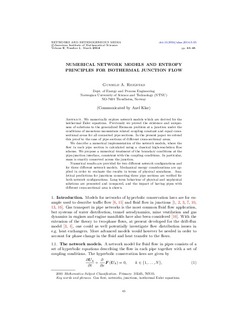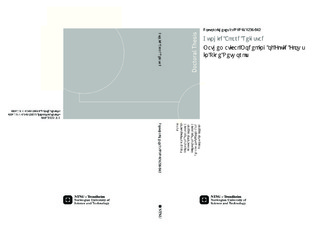| dc.contributor.author | Reigstad, Gunhild Allard | nb_NO |
| dc.date.accessioned | 2014-12-19T11:51:48Z | |
| dc.date.available | 2014-12-19T11:51:48Z | |
| dc.date.created | 2014-05-05 | nb_NO |
| dc.date.issued | 2014 | nb_NO |
| dc.identifier | 715731 | nb_NO |
| dc.identifier.isbn | 978-82-326-0164-6 (printed version) | nb_NO |
| dc.identifier.isbn | 978-82-326-0165-3 (electronic version) | nb_NO |
| dc.identifier.uri | http://hdl.handle.net/11250/235456 | |
| dc.description.abstract | The mathematical description of splitting and merging of flows is an important part of a detailed heat exchanger simulation model suitable for studying dynamic and static flow instabilities. This thesis considers one such description, the network models for fluid flow in junctions. Briefly described, these models consist of a one dimensional hyperbolic conservation law, the corresponding equation of state, coupling conditions and wave equations. In the present work, the generalized Riemann problem has been considered and thus each pipe section has a constant initial condition.
The set of coupling conditions enables the construction of boundary conditions at the pipe-junction interface of each pipe section connected at a junction. They are defined such that the boundary condition of each section is related to the initial conditions of all the connected pipe sections. The wave equations relate the constructed boundary condition and the initial condition of a pipe section under the restriction that the constructed state must propagate into the section.
This thesis mainly considers network models derived for the isothermal and isentropic Euler equations. A mandatory coupling condition is thus that mass is conserved at the junction. However, as the conservation laws consist of two equations, a second condition is needed. The choice of a momentum related coupling constant, H(, v), is common in the literature and has therefore been applied in this thesis as well. In particular, the proper selection of the coupling constant expression has been the main focus of the work.
Both pressure and momentum flux have been commonly applied as momentum related coupling constant in network models presented in the literature. In this thesis, existence and uniqueness of solutions to the generalized Riemann problem have been proved for network models that apply the two different constants. The proof is restricted to sets of initial conditions that belong to the subsonic region. That is, the region where both the initial conditions and the solutions are subsonic.
An investigation of the physical soundness of the solutions for a junction connecting three pipe sections revealed that none of the proposed coupling constants yield physical solutions for all subsonic flows at the pipe-junction interfaces. In particular, a duality was observed for isothermal flows. In the flow-ranges where pressure as coupling constant yields physical solutions, momentum flux yields unphysical solutions, and opposite. Unphysical solutions are characterised by the presence of energy production in a junction.
The lack of physically sound solutions within the entire subsonic region lead to a search for an alternative coupling constant. As a result, the Bernoulli invariant has been suggested and existence and uniqueness of solutions to the corresponding generalized Riemann problem have been proved for sets of initial data that belong to the subsonic region. It has also been proved that the constant yields physically sound solutions for all subsonic solutions.
A numerical implementation of three network models based on the isothermal Euler equations have been performed in addition to the theoretical investigation. The three different models applied pressure, momentum flux and Bernoulli invariant as momentum related coupling constant, respectively. Test cases for three different network layouts were derived, and corresponding numerical results presented. Each set of simulation results has been analysed with respect to physical soundness. All cases are seen to support the analytically based conclusion; only Bernoulli invariant as momentum related coupling constant yields physical solutions for all sets of initial conditions that belong to the subsonic region. | nb_NO |
| dc.language | eng | nb_NO |
| dc.publisher | Norges teknisk-naturvitenskapelige universitet, Fakultet for ingeniørvitenskap og teknologi, Institutt for energi- og prosessteknikk | nb_NO |
| dc.relation.ispartofseries | Doktoravhandlinger ved NTNU, 1503-8181; 2014:120 | nb_NO |
| dc.relation.haspart | Reigstad, Gunhild Allard; Flåtten, Tore. An Improved Roe solver for the drift-flux two-phase flow model.. Proceedings of the 8th international conference on CFD in the oil & gas, metallurgical and process industries: 366-374, 2012. | nb_NO |
| dc.relation.haspart | Reigstad, Gunhild A.; Flåtten, Tore; Haugen, Nils Erland; Ytrehus, Tor. Coupling Constants and the Generalized Riemann Problem for Isothermal Junction Flow. . | nb_NO |
| dc.relation.haspart | Reigstad, Gunhild A.. Numerical network models and entropy principles for isothermal junction flow. Networks and Heterogeneous Media. (ISSN 1556-1801). 9(1): 65-95, 2014. 10.3934/nhm.2014.9.65. | nb_NO |
| dc.relation.haspart | Reigstad, Gunhild Allard; Flåtten, Tore. Numerical Investigation of Network Models for Isothermal Junction flow. ENUMATH 2013 Proceedings, 2013. | nb_NO |
| dc.relation.haspart | Reigstad, Gunhild A. Existence and Uniqueness of Solutions to the Generalized Riemann Problem for Isentropic Flow. . | nb_NO |
| dc.title | Mathematical Modelling of Fluid Flows in Pipe Networks | nb_NO |
| dc.type | Doctoral thesis | nb_NO |
| dc.contributor.department | Norges teknisk-naturvitenskapelige universitet, Fakultet for ingeniørvitenskap og teknologi, Institutt for energi- og prosessteknikk | nb_NO |
| dc.description.degree | PhD i energi- og prosessteknikk | nb_NO |
| dc.description.degree | PhD in Energy and Process Engineering | en_GB |


